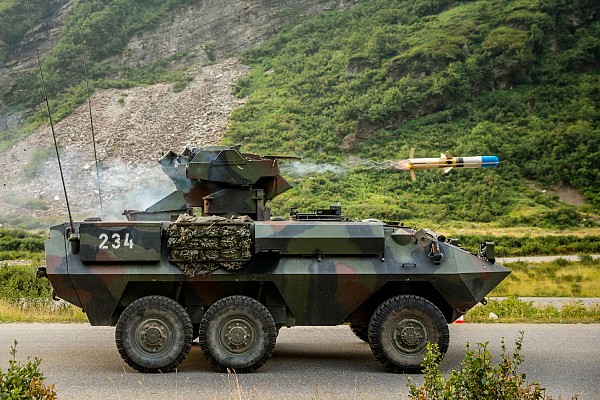BGM-71 TOW
Overview

BGM-71 TOW
US army soldier launching a TOW missile from a tripod mounted launcher.
Source: US Army -
© Public domain
BGM-71 (US military service)
Description
Introduction
The TOW is mid Cold War era anti-tank missile of US origin. It was developed in the 1960's to replace the older 106mm M40 recoilless rifle and French Entac and AS-11 missiles in US service. The name TOW is an abbreviation for "Tube-launched, Optically-tracked, Wire command data link, guided missile". The TOW was designed to be fired from tripod, vehicles and helicopters in order to reduce cost and ease logistics. Due to the continuous modernization of the missiles and launch systems the TOW remains an up to date weapon system that will remain in use for many years to come.
Design
The TOW missile is a wire guided missile that is launched from a tube. The missile has a conventional layout with the warhead at the front, cruciform wings in the middle, four control vanes and single-stage solid propellant rocket motor at the rear. Over time the warhead and other components have been updated to improve the performance.
Guidance
The TOW is wire guided and uses SACLOS guidance. The tracker included in the launch post detects the IR beacon on the missile and calculates course corrections. These are sent via the wire to the missile which adjusts course accordingly. This guidance mode requires the operator to man the launcher until the missile has hit its target.
Firepower
The TOW missile is a very capable missile and in its latest form can be used to take out most armored vehicles. The first version had a penetration of The maximum range is 3.75 km and a version with 4.5 km range is being developed. If not obscured by smoke the SACLOS wire guidance system ensures a good chance to hit the target, even when the target is moving.
Platforms
The TOW missile can be launched from the M220 tripod launcher. The M220 is very heavy and cumbersome and can only be carried over limited distances by infantry. Usually the launcher is mounted on a light vehicle such as the M151 MUTT and HMMWV. Other vehicle based launchers include the M901 Improved TOW Vehicle, M2 Bradley, LAV AT, Stryker and various non-US vehicles. The TOW can also be used by helicopters such as the compact Hughes MD-500 and many versions of the AH-1 Cobra attack helicopter.
Users
The first and foremost user of the TOW is the US military. The TOW is also used by most European nations and various other US allies around the world. Unlicenced copies, called the Toophan, are produced in Iran. The TOW is expected to remain in use with US forces until the year 2050.
Variants

BGM-71 TOW
Overview of TOW family of anti-tank missiles.
Source: Raytheon -
© Copyright lies with original owner
List of TOW variants
Details
Media
Platforms

Tripod
The tripod mounted launcher is commonly used with the TOW. It provides a solid platform, but is also quite heavy and only man-portable over short distances.

M151 Mutt
Many TOW launchers have been fitted to light open topped low silhouette utility vehicles such as the M151 MUTT.

HMMWV
The HMMWV is one of the primary platforms for the TOW launcher in use with US infantry formations.

AMX-PRAT
Dutch tank destroyer created by fitting a pedestal mounted TOW launcher to existing AMX-VCI armored personnel carriers.

Panzerjäger 90
Swiss tank destroyer based on the Piranha 6x6 wheeled chassis. Two TOW missiles are ready to fire.

M901 ITV
American tank destroyer based on the M113 chassis. The Emerson retractable launcher has two TOW missiles ready to fire.

LAV-AT
American tank destroyer based on the LAV-25 wheeled infantry fighting vehicle. The LAV-AT has two TOW missiles ready to fire.

YPR-765 PRAT
Dutch tank destroyer equivalent to the US M901 ITV, but based on YPR-765 chassis.

M2 Bradley
With over 6.000 Bradley's produced it is one of the main platforms the US military uses the TOW missile. The TOW-2 missile can be fired from the M2A1 and M3A1 versions onward.
Related articles

106mm M40
The TOW replaced the M40 recoilless rifle as a tripod and light vehicle mounted anti-tank weapon for infantry in the US army.

HOT
The French-German HOT missile is an anti-tank missile of similar size, range and guidance method. Unlike the TOW there are no man portable launch systems for the HOT.

9K113 Konkurs
The Konkurs (NATO: AT-5 Spandrel) is the Soviet counterpart to the TOW, having similar range and being wire guided as well.






